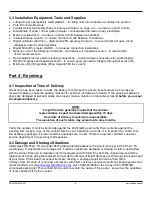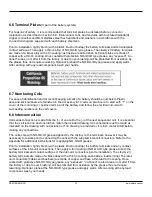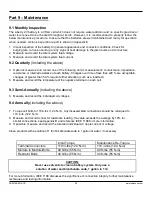
RS02109/0814/CD
5
www.cdtechno.com
Part 1 - Introduction
The Liberty 2V batteries (Liberty MSE or Liberty DCS) referenced in this document are stationary,
lead-acid batteries. They are constructed with an absorbent glass mat (AGM) and are characterized as
Valve Regulated Lead-Acid (VRLA). As VRLA, there is no free flowing electrolyte. They are constructed
with lead-calcium alloy grids, dilute sulfuric acid (electrolyte) enclosed in a flame retardant thermoplastic
container
(non-flame retardant container also available
) with a safety vent and a flame arresting disk to
prohibit a spark from entering the head space of the cell. This type of battery is nearly 100% recyclable.
At the end of life, please dispose of properly or consult C&D for recycling information.
The Liberty 2V batteries are designed to provide reliable service life with minimal maintenance when
used in accordance with this manual. They are a single cell unit producing a nominal two volts per
cell, which are connected in series for the desired system voltage. The cells are housed in steel modules,
coated with acid resistant paint. These modules come in varying heights, depending on the cell size
and two widths (3 cells wide and 4 cells wide), and can be stacked up to 84” high while maintaining
their seismic ratings.
The Liberty 2V series are to be installed in a horizontal position with all connections accessible from the
front of the system assembly. These cells are not designed for operation in any other orientation.
The Liberty MSE series is designed for float operation with minimal cycling. Typical applications include
Telecom, Switchgear/Control and other non-UPS applications which are subjected to 20 or fewer cycles
per year.
The Liberty DCS series is designed for cycling applications. Typical applications include Off-
Grid/Unreliable grid Telecom, Renewable energy or other stationary applications requiring a high number
of cycles throughout the life of the cell.
1.1 Cell Characteristics
Under normal float operation, Liberty 2V batteries can be installed in proximity to electronic equipment
and in computer rooms with occupied space. However, if subjected to excessive overcharge voltage,
hydrogen and oxygen can be vented into the atmosphere. Therefore, lead acid batteries should
never
be installed in an airtight enclosure. Sufficient precautions must be taken to prevent
excessive overcharge and containment of potential explosive off gases. All Lead-Acid batteries,
including Liberty 2V, are capable of generating excessive potentially explosive gases when charged for
prolonged periods at voltages higher than initial or equalizing charge. The Liberty 2V cells are equipped
with a “flash arrestor and pressure relief valve” assembly that seals the cells during normal charge
and operation but allows it to safely vent in case of overcharge. Removing the valve assembly can
cause the release of potentially explosive gases and such action will void the warranty.






































